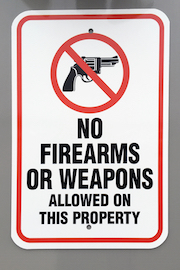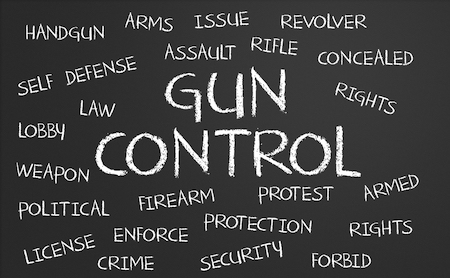How to Help Students Search for Consensus
A MiddleWeb Blog
 This fall my U.S. history students asked early on – even before the Paris and San Bernardino attacks – whether we could have a debate on gun control. I told them that we would do it in our Constitution unit mid-year, to connect with the Bill of Rights.
This fall my U.S. history students asked early on – even before the Paris and San Bernardino attacks – whether we could have a debate on gun control. I told them that we would do it in our Constitution unit mid-year, to connect with the Bill of Rights.
As the time came closer, however, the thought of holding a knock-down debate on guns made me uncomfortable. Why discuss physical violence with verbal violence?
So I decided to try something different: not debating the issue, but rather creating a “consensus document” as a class about gun laws in the United States.
How we set up the consensus process
Students read an overview of state gun laws for homework and listed three questions they wanted to research after reading the article. Then they spent a day in class looking for unbiased articles that would give them facts to help with our discussion.
For homework that night, each student wrote “3 specific and plausible ideas you would like to see implemented or continued in the United States regarding gun use or gun control.”
During a block period the next day, we dug into creating consensus.
- First, students met in groups of three or four to share all their ideas and winnow them down to one per person.
- Then each group merged with another group, forming circles of six or seven. Students shared their six or seven points and then winnowed them, again, this time to three per group.
- A spokesperson from each large group came up to my computer, and I typed in and projected each group’s top three points. The ideas didn’t even begin to reach complete consensus, but there were some on which most students agreed. For instance: “We need to increase background checks and have stricter background checks” or “Newspapers should focus less on mass shooters so that people don’t become inspired to do ‘copycat shootings.’”
- With the little time remaining, we briefly discussed the benefits and drawbacks of each of the points.
- Students wrote a five-minute response on what they had learned from the day’s class about gun laws and/or the process of coming to an agreement.
What we learned in the process
By the end of each block period, even though the majority of my Southern California students tilted liberal on gun control, we hadn’t begun to reach complete agreement. But we did learn a lot in the process:
- Facts matter.

By the end of class, students at least realized how much more they needed to know. As Matt observed, “I learned that in most states gun laws are extremely weak or not in place. In California there are very strict gun laws, while in Texas gun laws are very weak. The only way to change this would be to pass federal laws.”
A favorite moment came in my second class. The day before, Sam had asked if he could give an overview of California’s gun laws, as he and his dad are experts in the topic. He took the floor for several minutes, summarizing a dozen points so cogently that his classmates kept referring to them throughout the discussion.
- History pops up in the most unexpected places.
Even in a discussion about current events, the history we had already studied entered in.
Ideas from our unit on federalism – the tension between the national and state governments that Louis Brandeis described as a “laboratory” for democracy – appeared over and over again, as students could not believe the disparity in gun laws from state to state.
Reaching back more than two centuries, Alec reflected, “It is a lot more difficult to come to an agreement than I thought, so I have a new respect for the people who created the Constitution.”
And Ellen understood Congressional impasses a little better when she wrote: “Today I learned that creating laws is not as easy as it seemed. Before, my thought process was: Why doesn’t the government just make a law protecting citizens from guns, but to make that law, much thought has to go into it.”
- Coming to consensus can be loud!
For some reason I imagined that, since we weren’t having a debate, the group discussions would be models of propriety.
And a few of them were – but only because everyone in the group pretty much agreed.
One group was so divided that it simply couldn’t come to any consensus – and one day the next week, when I was absent, the sub said that one of the group members wanted to restart the debate after watching a video on the Supreme Court.
This kind of enthusiasm is golden, but not when it overwhelms the discussion.

Next time I would lay the ground rules of listening to each other more clearly. I might also suggest the formal framework of a Socratic seminar, encouraging everyone to talk only two or three times and not to dominate conversation.
However, with so many groups going at once, I was not able to monitor every conversation. And I did like the sense that different “committees” were hashing out ideas on their own rather than directing everything toward my ears.
One solution might be to have everyone in the class write an assessment at the end of how much they talked and to mention anyone who seemed to dominate or shy away from conversation. I might also ask my students beforehand which kinds of ground rules they think would keep passions under control.
Would I do this again?
There’s no question that, with a little more factual background and a discussion of the rules of the game beforehand, I would absolutely do this again.

Many of their proposals also left me thinking and made me smile.
Take this one, inspired by what students learned about the brain in 7th grade life science: “You have to be 25 or older to buy a gun so that your frontal lobe is developed and you will ideally make better choices.”
This from 13- and 14-year-olds – yet another reason I teach middle school!







































Bravo! This is a tough topic and kids really enjoy having the conversation. The fact that you reflected and students reflected on their learning is the most powerful thing. That is how things get done! Kudos to you and your kids.
I have enjoyed (and students love them) doing deliberations with my 8th graders. They all are organized and give a background reading which is a good jumping off point. All are hot debatable topics. Here is the link: http://www.deliberating.org
What a wonderful site! Are there any particular topics you’ve enjoyed, and how do you structure the deliberations?
I began following the specific lesson plan that was given on the website attached to each topic. They were structured and kind of kept me out of trouble :)
Then I realized I wanted my students to think outside the box and I began to experiment with the structure and “how it is done” of the deliberations. One thing remained the same, we weren’t arguing or finding an opinion. This was a deliberation, not a debate or discussion. Disagree with the point but not the person. I have really enjoyed topics that bring students outside the research and makes them want to back up their arguments with more sources. Death Penalty, Recycling, Juvenile Justice, Violent Video Games, Youth Curfews are all topics students gravitate toward. They are meaningful in their lives now and allow for great discussion.
The topics sound really high interest, and “deliberation” has a nice ring to it. Thanks for the details!